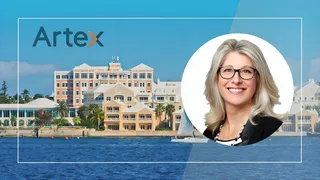
From niche to core: Artex’s Faries on the next chapter of ILS
As the global reinsurance ecosystem continues to evolve, the convergence of capital markets and re/insurance has never been more relevant – or more visible – than it is today. For Kathleen Faries (pictured), CEO of Artex Capital Solutions, Bermuda’s innovation hub remains central to this transformation.
Ahead of Convergence 2025, taking place 13-15 October 2025, Faries told Bermuda:Re+ILS her take on how the industry is adapting, and why the next phase of Insurance-Linked Securities (ILS) could redefine both reinsurance and risk investment.
“ILS will continue to go from niche to a core component of the global reinsurance ecosystem and alternate asset industry,” Faries said. “We’ve seen both public and private reinsurance transactions grow significantly, with the asset class now representing about 15% of the reinsurance market.”
That evolution – from experimental structures to an established alternative capital pillar – has been one of Bermuda’s most significant success stories over the past decade. Artex, with its expansive platform and cross-market expertise, has been instrumental in helping investors and cedants alike navigate that complexity.
“Because of our size and breadth of expertise, we can support what our investor base is interested in accessing – regardless of line of business, complexity, or form of risk transformation,” Faries explained. “We’re positioning ourselves to continue leading the industry, innovating with our partners, and providing valuable data insights to our clients.”
Balancing innovation and discipline
For Faries, innovation cannot come at the expense of operational rigour. Artex’s growth strategy is built on balancing these forces – particularly as technologies such as AI and blockchain begin to reshape reinsurance infrastructure.
“Navigating change is one of the most critical challenges facing leaders today – especially in a fast-paced, high-growth environment,” she said. “At Artex, this challenge is amplified by the rapid evolution of AI and decentralised ledger technology, which brings both transformative opportunities and complex risks.”
Artex’s answer is a measured, data-driven approach. The company employs agile methodologies, “anchored by tightly managed sprints and clear milestones,” designed to deliver measurable impact while minimising client disruption. A dedicated head of business transformation ensures execution stays aligned with strategic priorities.
Faries says the firm is “energised by the transformation underway in Q4 and into 2026” as it accelerates toward becoming “a truly data-driven organisation – one that leverages technology to enhance decision-making, improve operational efficiency and deliver even greater value to clients.”
Climate, capital and closing the gap
For an asset class once defined by its focus on natural catastrophes, ILS is now being looked to for solutions to some of the world’s most urgent climate and protection challenges.
“Insurance-linked securities are uniquely positioned to help address climate change risk and close global protection gaps,” Faries said. “By mobilising alternative capital, ILS can fund climate resilience initiatives and transfer risk for emerging perils like floods and wildfires – areas increasingly impacted by climate change.”
Catastrophe bonds and parametric structures, she notes, are particularly effective tools for fast, scalable recovery, especially in underserved regions where traditional insurance penetration remains low. “ILS also supports public-private partnerships, enabling governments and insurers to build multi-year, multi-peril coverage that enhances recovery and resilience,” she adds.
Better data and more refined climate models will be crucial. “As modelling and data analytics improve, ILS will play a critical role in pricing climate-sensitive risks more accurately and transparently,” Faries says. “Artex is actively advancing this evolution through innovative structuring, transformation and strategic engagement with investors and clients.”
Evolving beyond cat: Liquidity, regulation and discipline
With investors increasingly drawn to multi-year and non-cat exposures, Faries sees the next phase of ILS growth unfolding along more diversified, and potentially longer-term, lines.
But she cautions that three challenges stand out: “Excess capacity and underwriting discipline; regulatory scrutiny and constraints; and liquidity,” she said.
Each, she argues, demands active management. “Long-term stability and profitability require robust valuation practices, transparency, and reliable execution. We continue to provide investors and distribution partners with the infrastructure and expertise that support disciplined growth.”
Regulation is another area of focus. “As the market grows, regulatory trends for collateralised transactions may result in additional requirements – and higher transaction costs,” she noteed. Artex, she said, is investing in “a best-in-class corporate governance, regulatory and legal team” to stay ahead of that curve.
Liquidity, too, remains top of mind for investors seeking greater flexibility and exit optionality. “Artex is exploring how we can efficiently deliver these options for our risk transformation clients,” Faries said. “The legacy reinsurance market is responding to this opportunity, and we’re actively discussing how to support efficient access.”
Lessons from Bermuda’s playbook
For Faries, Bermuda’s leadership in ILS remains rooted not in theory but in practice. “Learning, in large part, comes from ‘doing,’” she said. “Bermuda’s advantage remains our years of ‘doing’ and innovating with our distribution and risk-taking partners.”
That experience continues to shape how the island approaches both innovation and regulation – balancing agility with accountability. “What’s exciting about this industry,” Faries adds, “is that there is always evolution, learnings to be had, and exciting developments that push the industry forward for the good of society.”
Data and technology: the next disruptors
Looking ahead, Faries sees AI and decentralised ledgers as key catalysts for further change. “AI-first platforms are enabling companies to rethink their core architecture,” she says, “moving from fragmented systems to intelligent, integrated cloud-based platforms that support automation and real-time analytics.”
The ability to process and connect massive data sets will transform how risks are understood and priced. “Ideally, this all works together to allow a more efficient, transparent and consistent view of risk over time,” Faries concluded.
For Bermuda – and for Artex – the message is clear: the next decade of ILS won’t just be about capacity, but capability. The firms that win will be those that can combine innovation, data, and discipline to move from niche to indispensable.
Did you get value from this story? Sign up to our free daily newsletters and get stories like this sent straight to your inbox.

